Similar presentations:
The Great Britain
1.
GreatBritain
The Impact of the Past
on the Development
of the British
Political System
2.
The British Isles are a group of islandsoff the northwest coast of continental
Europe.
They are bounded on the west
by the Atlantic Ocean, the
Celtic Sea, St. George’s
Channel, the Irish Sea and
Ireland.
to the north . . . the North Sea,
to the south, the English
Channel
3.
4.
CONSTITUENT COUNTRIESOF THE BRITISH ISLES
The British Isles comprise
Great Britain, Ireland, and
a number of smaller islands
(Isle of Man & Channel Islands).
Two sovereign states located in
the islands:
The United
Kingdom
of Great Britain and
Northern Ireland
+
The
Republic of Ireland
5.
THEUNITED KINGDOM OF
GREAT BRITAIN AND NORTHERN IRELAND
The United Kingdom is
a constitutional monarchy
composed of 4 constituent
countries
England
Scotland
Wales &
Northern Ireland.
6.
British Isles / UK / Britain / England7.
THE UNION JACKThe Union Flag (also known as
the Union Jack) is the national
flag of the United Kingdom of
Great Britain and Northern
Ireland.
Its design includes the flags
of
England
Scotland
Ireland
8.
ENGLANDEngland
the largest & most populous
constituent country of the
United Kingdom of Great
Britain and Northern Ireland.
Capital: London.
Flag: St. George’s cross.
9.
SCOTLANDScotland
is one of the
four constituent countries of
the United Kingdom of Great
Britain and Northern Ireland.
Capital: Edinburgh.
Flag: Cross of Saint Andrew.
10.
WALESWales is one of four
constituent countries of the
United Kingdom of Great Britain
and Northern Ireland.
Capital: Cardiff.
Flag: the red dragon of Prince
Cadwalader plus the
Tudor colours .
11.
THE REPUBLIC OF IRELANDThe Republic of
Ireland is a member of
the European Union.
Capital: Dublin.
Flag: Green, white,
orange.
12.
NORTHERN IRELANDNorthern Ireland –
The Irish province of Ulster remains
occupied as Northern Ireland, still a
part of the United Kingdom and 1 of 4
constituent countries of the United
Kingdom of Great Britain and
Northern Ireland.
Capital: Belfast.
Flag: the Union Flag is the
official flag
. . . Wanna fight about
13.
BritanniaInsulae
Est
14.
From Shakespeare’s Richard III:
This other Eden, demi-paradise,
This fortress built by Nature for herself
Against infection and the hand of war,
This happy breed of men, this little world,
This precious stone set in the silver sea,
Which serves it in the office of a wall,
Or as a moat defensive to a house,
Against the envy of less happier lands,
This blessed plot, this earth, this realm,
this England,
15.
Geographic Providence England is an islandInsularity
Relative peace & security
Ethnic, linguistic, religious . . . Cultural Homogeneity
Less need for a standing army
Navy . . . Navigation . . . Necessity of Trade
Far distant from papal authority
Greater independence and self governance
We’ll return to these points later
16.
TRADITIONPERMEATES BRITISH
POLITICS
The Opening of
Parliament –
Black Rod
& the Slammed Door
Pageantry, drama,
history, & legitimacy
17.
Members of House ofCommons are each
year summoned to
Lord’s Chamber to
dutifully hear the
Queen’s commands to
Parliament for the next
year’s session
in the “Queen’s
Speech from the
Throne”
18.
“Queen’s Speechfrom the Throne”
NOT her speech!
She did not write it
She may not even
agree with it . . .
But she MUST read it
to Parliament
Who’s in charge?
19. Parliament vs. the Monarch
A bit of background . . . .20.
House of Commons, 1642King Charles I led troops into Commons to arrest 5 leading
dissident Members of Parliament (MPs).
the five received warning, escaped. Avoided bloodshed on the
floor of House of Commons.
Finding the five had flown, the King angrily threatened the
Speaker, Lenthall, whose reply has become legendary, -
“May it please your
Majesty, I have neither
eyes to see, nor tongue
to speak in this place,
but as this House is
pleased to direct me,
whose servant I am.”
- Speaker Lenthall
21.
A yearly dramareminding
Britons of
where
Power
resides . . .
King ? or
Commons?
22.
23.
24.
What’s the symbolism?25.
Traditions, Rituals, Ceremony,and Pageantry
reinforce the dignity of government
legitimize government by evoking historical
memories
impress upon Govt officers weight of office dignity, responsibility, duty
provide continuity w/ past
engender legitimacy & patriotism through
pageantry
promote national unity
26.
Prehistoric to 1000 yrs agoEarliest
Britain
Celtic Britain (arrive 500 BC)
Romano-Celtic Britannia (43 AD to 410).
(Romans 1st arrived 55 BC)
Roman law, peace, trade, Christianity
Hadrian’s Wall
Withdrawal of Roman power in 5th Century AD
Angles,
Saxons, Jutes 5th Century
Norman England
The Danelaw
27.
Celtic Britain:Britons
Scots
Welsh
Irish
Cornish
28.
Celtictribes of
Britain
29.
Celtic Britain30.
Anglo-Saxon Britainfeudal aristocracy - weak
kings
Post Roman reality memory of central govt
and its desirability
but
feudal fractionalization
Anglo-Saxon Witan
King's council of nobles
tribal, clannish, scattered
power
Related to Scandinavian /
Viking system
• eg. Icelandic ALTHING
lacked focus / centralization
/ power too dispersed
31.
32.
The Lord's Prayer in Olde EnglishMatthew 6:9-13
Fæder ure þu þe eart on heofonum; Father our thou that
Si þin nama gehalgod
to becume þin rice
gewurþe ðin willa
art in heavens
be thy name hallowed
come thy kingdom
be-done thy will
on eorðan swa swa on heofonum.
on earth as in heavens
urne gedæghwamlican hlaf syle us todæg
and forgyf us ure gyltas
our dailybread
give us today
and forgive us our sins
swa swa we forgyfað urum gyltendum
as we forgive thosewho have-sinned-against-us
and ne gelæd þu us on costnunge and not lead thou us into
temptation
ac alys us of yfele. soþlice
but deliver us from evil. truly.
33.
34.
Norman EnglandNorman Conquest
William the . . . . unofficial heir
1066 battle of Hastings
• William… the Conqueror
Centralization of power
Domesday Book
Exchequer
35.
Norman EnglandNorman Conquest
brought Wm's own nobility & a plan to
organize & govern England
* William replaced the entire English
ruling class w/Norman nobles
and his rule was backed by brutal
military power and much better
administration plan
36.
Norman Englandand so political stability & centralization
were brought to England relatively
early: earlier than in continental Europe
* however, while sovereign power
resided in the Monarch,
British Kings were still expected to
consult w/the earls, barons, and
leading clergymen (i.e., nobility) in
order to declare laws and levy taxes
37.
38.
Norman ReformsCarta 1215 – explicit protection of
feudal customs, rights, and law
Rule of law – the LAW is the King
Limited monarchy
Magna
implies individual rights
power sharing
King rules w/ Lord’s advice & consent – parliament
Mixed monarchy
Common
Law
39.
Common LawPrior to Norman Conquest,1066, justice was
administered primarily by county courts
Courts were presided over by diocesan bishop or
by county sheriff
both ecclesiastical & civil
jurisdiction.
Trial by Jury began in
these courts.
40.
Common LawBy
1150s Henry II began sending judges
from his own central court to hear disputes
throughout England,
resolving cases on an ad hoc basis.
Judge-made law, legal precedent, jury
trial, - Supremacy of Law
Stare Decisis - Precedent
curbed power of canonical (church) courts
and manoral courts (feudal)
41. Magna Carta of 1215
KingJohn recognized it as a right of his
subjects “to have common council of the
kingdom” for the assessment of
extraordinary aids
Taxation
crafting law
war
military conscription
42.
43.
Consequences of Common Lawconflict of King w/ church
most famously with Thomas á Becket, Archbishop of
Canterbury
Writ of Right - Royal order for a feudal lord to
provide justice to plaintiff or the King would
intercede through the Sheriff
• )Writ of Praecipe - ignored manoral courts, ordered
disputed lands to be restored to plaintiff or have defendant
appear in King’s Court to explain
• )in effect an automatic presumption against the feudal
lord
)encouraged and empowered the rising middle
class
44.
WalesEdward
I brings Wales under British
sovereignty in 1283
Prince of Wales
45. Sovereignty
powerwas still largely in the hands of the
Monarchy who ruled by divine right
Kings and Queens of Britain were
practicalities nonetheless required to
consult Parliament before levying taxes or
making law
tensions b/n Crown and Parliament grew.
46.
47.
* Parliament’s power got a major boost duringthe reign of Henry VIII (1509-1547) when Henry
formed a partnership w/ the Parliament in his
struggle w/ Rome
Henry VIII wanted a divorce because Catherine
couldn’t bear him a male child,
Pope wouldn’t grant it
so Henry (w/Parliament’s consent) bolted
Catholic Church and
created Church of England :
Henry’s new church, with Henry as its head,
granted the divorce
48.
Protestant ReformationHenry
VIII
Break w/ Rome
Elizabeth
I
1588 Defeat of the
Spanish Armada
Colonization
Mercantilism
Commercial Culture
James
I and the Stuart dynasty stew
49. Good Queen Bess Elizabeth I
50. Eventually the tensions b/n the institutions boiled over, as the efforts of the Stuarts (Charles I & James II) to centralize
Eventually the tensions b/n the institutions boiled over,as the efforts of the Stuarts (Charles I & James II) to
centralize authority in the 1600s led to all out war b/n
Crown & Parliament
* Charles I took England to unsuccessful wars w/Spain
and France
which increased his desperation for $
and
Charles tried to levy taxes w/o consent of the Parliament
51.
Charles IEnglish Civil War
(1642-48)
"who should rule the
country?"
Parliamentarians vs.
Royalists
(1625-1649)
52.
ParliamentariansPuritans – Roundheads
House of Commons
Merchant class
Oliver Cromwell
New Model Army
Royalists
Aristocratic, supported King
called Cavaliers
House of Lords & the Court
Roman Catholics or High
Church of
England
53.
54.
Charles I beheaded by Parliament55.
TheGlorious Revolution
1689
James
II ousted
Parliament invites William & Mary to the throne
Bill of Rights – relationship between Parliament
and Crown – shared rule
1714, Anne w/out heir, Parliament invites
George of Hanover
56.
The English Bill of RightsTo prevent abuse of
power by William &
Mary
and all future
monarchs, Parliament,
in 1689, drew up a list
of provisions to which
Wm & Mary had to
agree.
57.
This document, the English Bill of Rights,prohibited a standing army in peacetime,
except with the consent of Parliament
required that all parliamentary elections be free.
Monarch's authority,
only with consent of
Parliament
guarantees right to a fair trial, freedom from excessive bail
and protection from cruel and unusual punishment.
Our nation has built on,
changed, & added to
those ideas and
institutions that settlers
brought here from
England.
58.
Political Reform 19th CenturyIndustrialization
Population shifts
Inequities
exploitation
Dickens’ Novels
riots in 1819 led the
Reform Act of 1832
Chartist Movement in
the 1830s and 1840s
59.
60.
61.
Representation of the People Act1832, commonly known as the
,
Reform Act 1832
62.
The Great Reform Act of 1832Began 1760 as reaction to supposed autocratic policies of
the new young King George III
began The early liberal or radical tradition in Britain
culminated with the Great Reform Act of 1832.
Masterminded by liberal Whig Earl Grey
abolished the so called “Rotten Boroughs” in England
led to complete overhaul of the entirely venal electoral
system in Scotland
Extension of the franchise across Britain.
early beginnings of modern mass democracy in the UK
63.
64.
Industrial Erastart of the modern party-political system
Liberally-minded Whigs gradually organised themselves
into the Liberal Party
those holding more conservative views – nicknamed
“Tories” by their liberal opponents
(Tory was a term of abuse by the late 18th century)
– organised themselves into the Conservative Party
and gradually adopted term “Tory” for themselves
65.
In The Tree ofCorruption from
1831, caricaturist
H. H. Heath
depicts hacking
away the old
Rotten Borough
System,
to the strenuous
protests
from those whose
livelihood depend
on it.
© the Library of Congress.
66.
The Great Reform Act of 1832Removed Rotten Burroughs / Pocket Burroughs
disenfranchised 56 boroughs in England & Wales and
reduced another 31 to only one MP
created 67 new constituencies
broadened the franchise's property qualification in the
counties, to include small landowners, tenant farmers,
and shopkeepers
67.
The Great Reform Act of 1832created a uniform franchise in the boroughs, giving the vote
to all householders who paid a yearly rental of £10 or more
and some lodgers
Expanded franchise among middle class
7% of adult Brits could vote
House of Commons to represent masses
2nd Reform Act 1867
2X electorate to 16%
3rd Reform Act 1884
nearly
universal male suffrage
68.
2nd Reform Act 18672X electorate to 16% of pop.
3rd Reform Act 1884
nearly universal male suffrage
69. When the Houses of Parliament burnt down in 1834, Queen Adelaide openly spoke of it being God's just punishment for passing the
Great Reform Act70.
Political Reform 20th Century– Labour Party speaks for the
working class & socialist reforms
Parliamentary Acts in 1911 stripped all the
remaining significant powers away from
the aristocratic House of Lords
reform of the system made Britain a more
substantive and expansive democracy
was complete
1900
71. Women’s suffrage Emmiline Pankhurst, suffragette leader, used arson and window smashing to further their cause - “breaking
glassis the most
eloquent argument
in politics.”
72. Emmeline Pankhurst being arrested in 1914
73.
•1918 the Representation ofthe People Act
gave
women over 30 yrs old the vote if they
were householders, or wives of householders
occupiers of property w/ an annual rent of £5
or if they were graduates of British
universities.
enfranchised only about 8.5 million women
Ten years later, in 1928, women won the right
to vote on the same terms as men.
74. WWII & Churchill
WWII & Churchill75.
76.
WWII & Post-War Britain1939-45
World War II
1945 – Labour takes power
the beginning of the British
Welfare State
77.
78.
79. PM Margaret Thatcher - Conservative Prime Minister of the UK from 1979 to 1990
PM Margaret Thatcher Conservative Prime Minister ofthe UK from 1979 to 1990
80. PM Tony Blair – New Labour Prime Minister 1990 - 2007
81. Current PM David William Donald Cameron
Current PMDavid William
Donald Cameron





















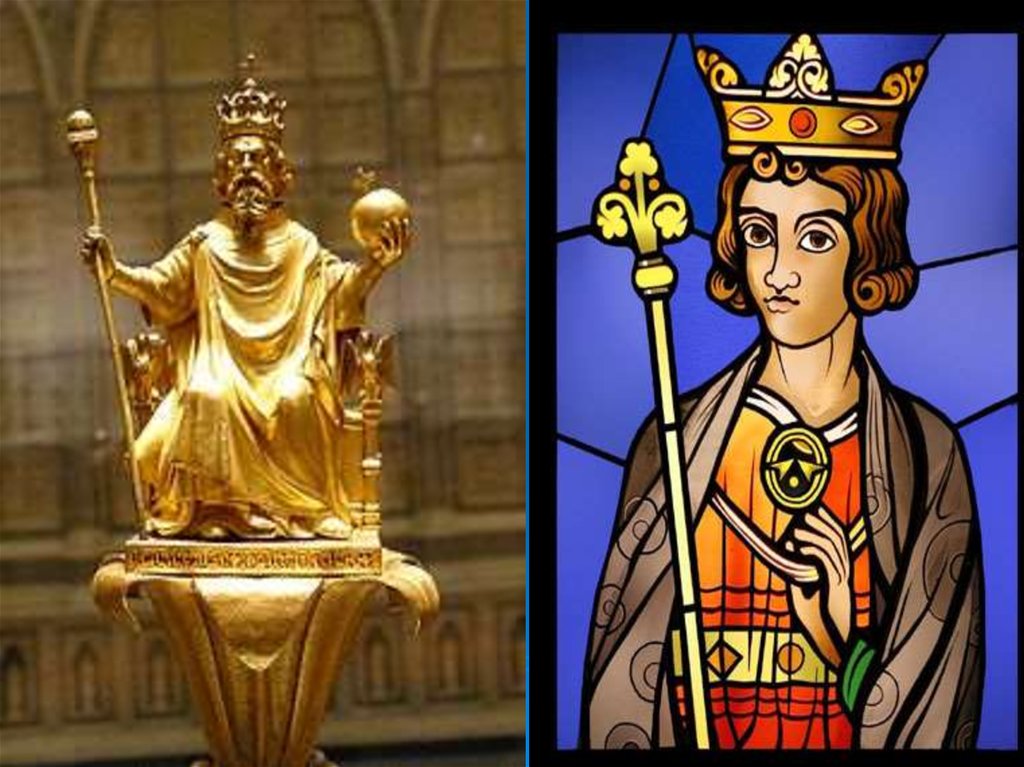












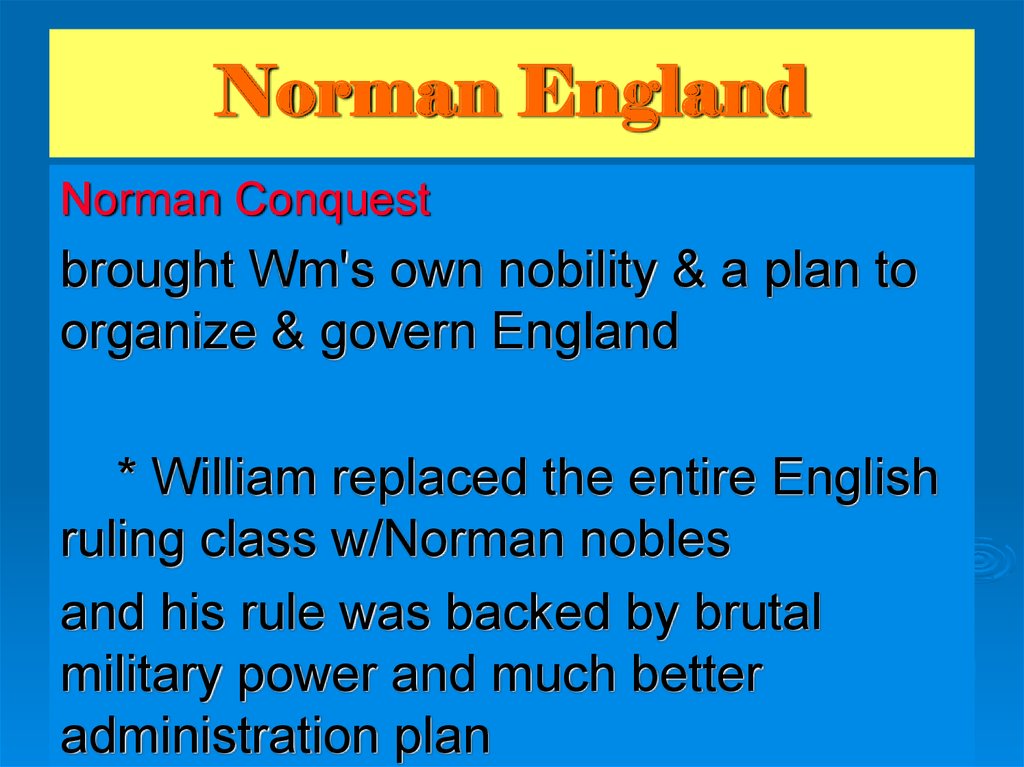

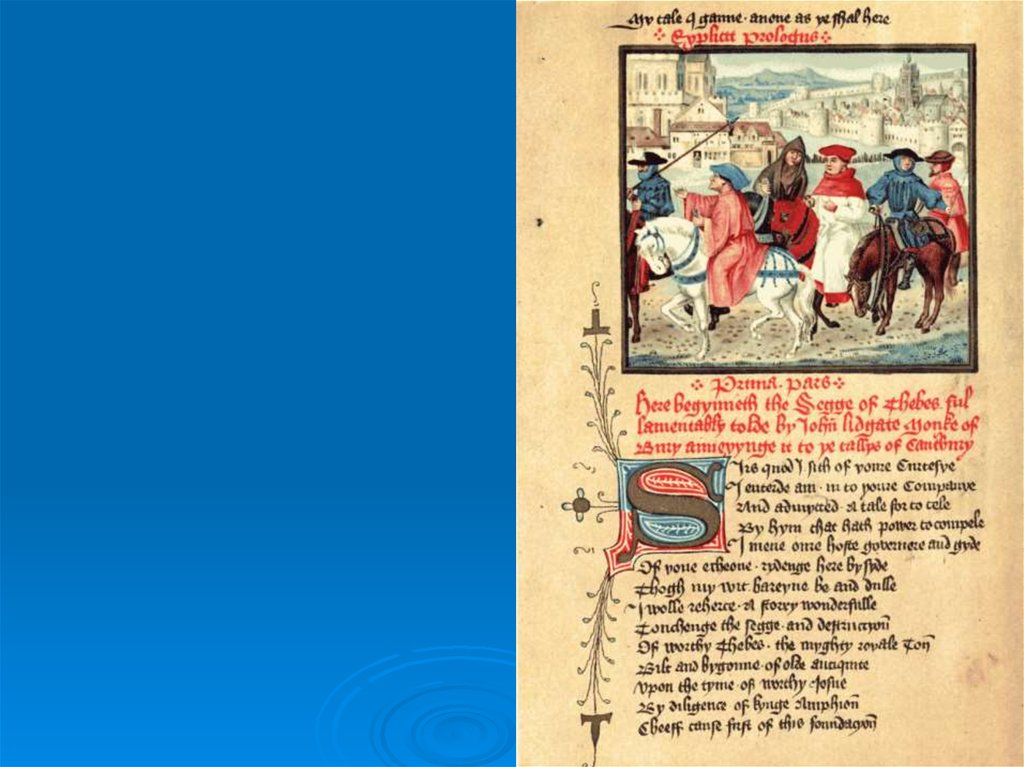























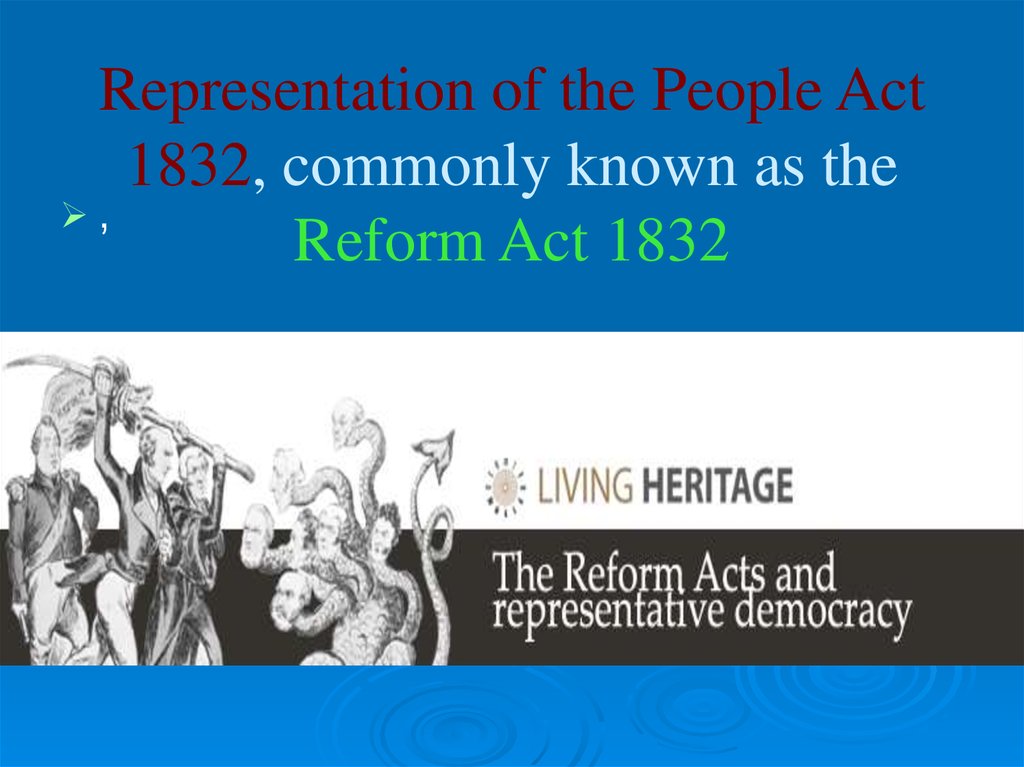
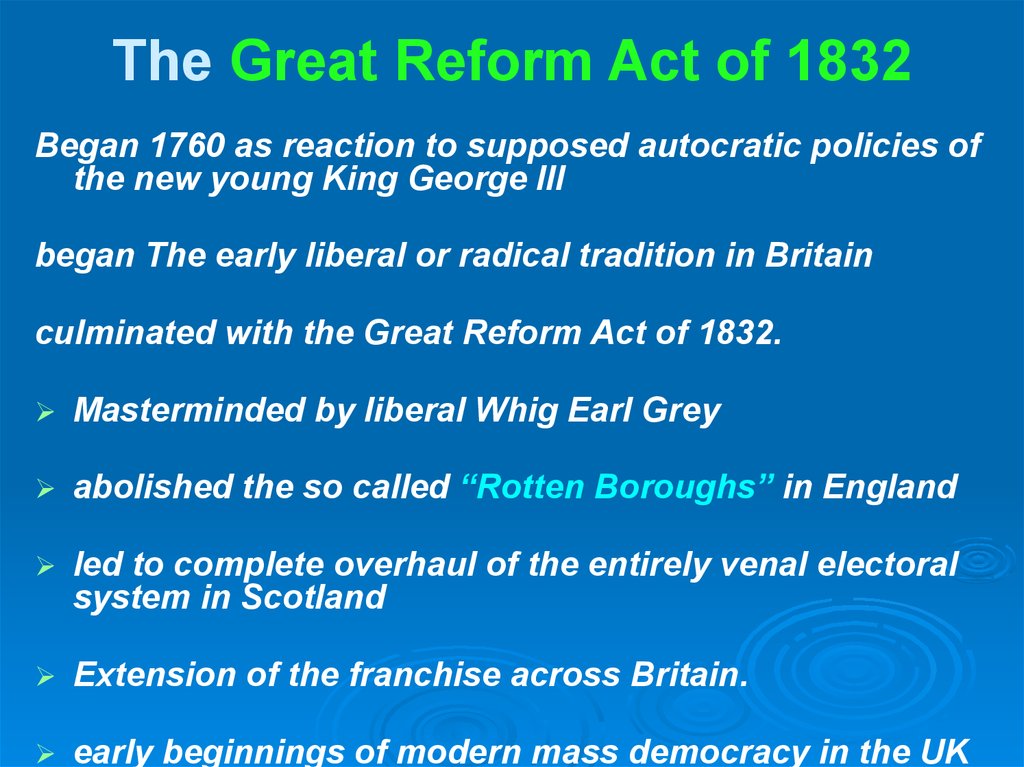
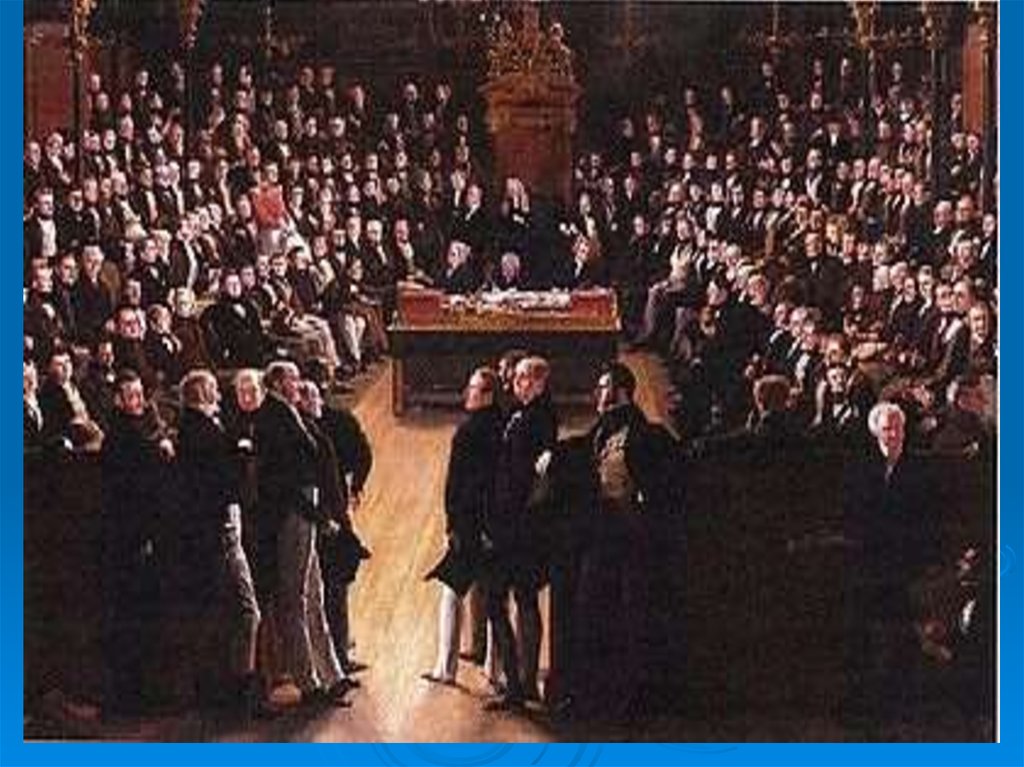


















 history
history geography
geography








